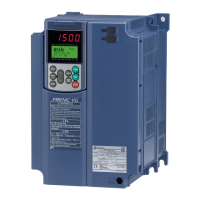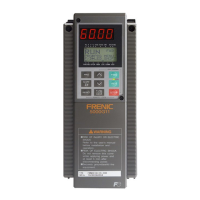5-102
F codes
E codes
C codes
P codes
H codes
A codes
b codes
r codes
J codes
d codes
U codes
y codes
Chap. 5 FUNCTION CODES
Starting Mode (Auto search delay time 1) (H49) Data setting range: 0.0 to 10.0 (s)
Auto search for the idling motor speed will become unsuccessful if it is done while the motor retains residual voltage. It
is, therefore, necessary to leave the motor for an enough time for residual voltage to disappear. H49 specifies that time
(0.0 to 10.0 sec.).
At the startup triggered by a run command ON, auto search starts with the delay specified by H49. Using H49, therefore,
eliminates the need of the run command timing control when two inverters share a single motor to drive it alternately,
allow the motor to coast to a stop, and restart it under auto search control at each time of inverter switching
Starting Mode (Auto search delay time 2) (H46) Data setting range: 0.1 to 10.0 (s)
At the restart after a momentary power failure, at the start by turning the terminal command BX ("Coast to a stop") OFF
and ON, or at the restart by auto-reset, the inverter applies the delay time specified by H46. The inverter will not start
unless the time specified by H46 has elapsed, even if the starting conditions are satisfied.
Under auto search control, the inverter searches the motor speed with the voltage applied at the motor start and the
current flowing in the motor, based on the model built with the motor parameters. Therefore, the search is greatly
influenced by the residual voltage in the motor.
At factory shipment, H46 data is preset to a correct value according to the motor capacity for the general purpose motor,
and basically there is no need to modify the data.
Depending on the motor characteristics, however, it may take time for residual voltage to disappear (due to the
secondary thermal time constant of the motor). In such a case, the inverter starts the motor with the residual voltage
remaining, which will cause an error in the speed search and may result in occurrence of an inrush current or an
overvoltage alarm.
If it happens, increase the value of H46 data and remove the influence of residual voltage. (If possible, it is
recommended to set the value around two times as large as the factory default value allowing a margin.)
• Be sure to auto-tune the inverter preceding the start of auto search for the idling motor speed.
• When the estimated speed exceeds the maximum frequency or the upper limit frequency, the inverte
disables auto search and starts running the motor with the maximum frequency or the upper limit frequency,
whichever is lower.
• During auto search, if an overcurrent or overvoltage trip occurs, the inverter restarts the suspended auto
search.
• Perform auto search at 60 Hz or below.
• Note that auto search may not fully provide the expected/designed performance depending on conditions
including the load, motor parameters, power cable length, and other externally determined events.
H11 Deceleration Mode
H11 specifies the deceleration mode to be applied when a run command is turned OFF.
Data for H11 Function
0 Normal deceleration
1
Coast-to-stop (The inverter immediately shuts down its output, so the motor stops
according to the inertia of the motor and machinery (load) and their kinetic energy losses.)
When reducing the reference frequency, the inverter decelerates the motor according to the deceleration
commands even if H11 = 1 (Coast-to-stop).
H12 Instantaneous Overcurrent Limiting (Mode selection) (Refer to F43.)
H13, H14
H15, H16
Restart Mode after Momentary Power Failure (Restart time, Frequency fall rate,
Continuous running level, and Allowable momentary power failure time)
(Refer to F14.)

